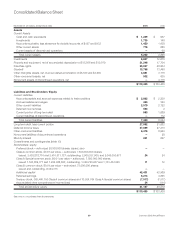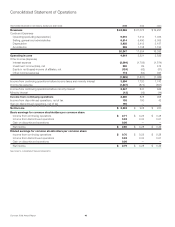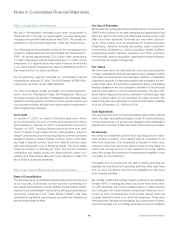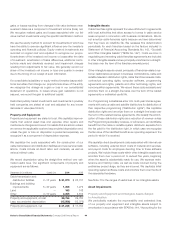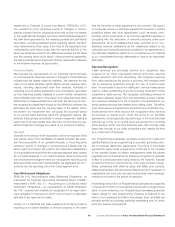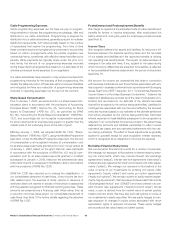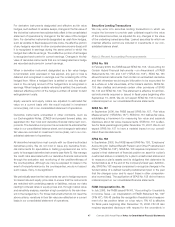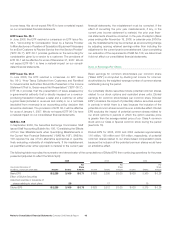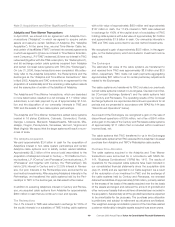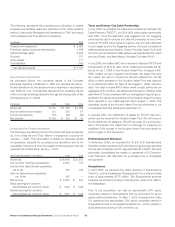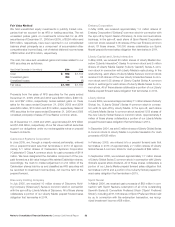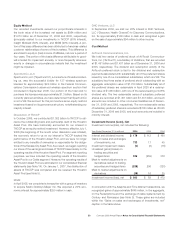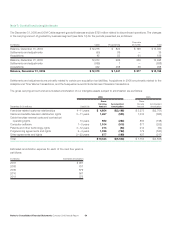Comcast 2006 Annual Report Download - page 49
Download and view the complete annual report
Please find page 49 of the 2006 Comcast annual report below. You can navigate through the pages in the report by either clicking on the pages listed below, or by using the keyword search tool below to find specific information within the annual report.
47 Comcast 2006 Annual Report Notes to Consolidated Financial Statements
For derivative instruments designated and effective as fair value
hedges, such as fixed to variable swaps, changes in the fair value of
the derivative instrument are substantially offset in the consolidated
statement of operations by changes in the fair value of the hedged
item. For derivative instruments designated as cash flow hedges,
such as variable to fixed swaps and rate locks, the effective portion
of any hedge is reported in other comprehensive income (loss) until
it is recognized in earnings during the same period in which the
hedged item affects earnings. The ineffective portion of all hedges
is recognized each period in current earnings. Changes in the fair
value of derivative instruments that are not designated as a hedge
are recorded each period in current earnings.
When a derivative instrument designated as a fair value hedge
is terminated, sold, exercised or has expired, any gain or loss is
deferred and recognized in earnings over the remaining life of the
hedged item. When a hedged item is settled or sold, the adjust-
ment in the carrying amount of the hedged item is recognized in
earnings. When hedged variable-rate debt is settled, the previously
deferred effective portion of the hedge is written off similar to debt
extinguishment costs.
Equity warrants and equity collars are adjusted to estimated fair
value on a current basis with the result included in investment
income (loss), net in our consolidated statement of operations.
Derivative instruments embedded in other contracts, such as
our Exchangeable Notes, ZONES and prepaid forward sales, are
separated into their host and derivative financial instrument com-
ponents. The derivative component is recorded at its estimated fair
value in our consolidated balance sheet, and changes in estimated
fair value are recorded in investment income (loss), net in our con-
solidated statement of operations.
All derivative transactions must comply with our Board-authorized
derivatives policy. We do not hold or issue any derivative finan-
cial instruments for speculative or trading purposes and are not a
party to leveraged derivative instruments (see Note 8). We manage
the credit risks associated with our derivative financial instruments
through the evaluation and monitoring of the creditworthiness of
the counterparties. Although we may be exposed to losses in the
event of nonperformance by the counterparties, we do not expect
such losses, if any, to be significant.
We periodically examine the instruments we use to hedge exposure
to interest rate and equity price risks to ensure that the instruments
are matched with underlying assets or liabilities, reduce our risks
relating to interest rates or equity prices and, through market value
and sensitivity analysis, maintain a high correlation to the risk inher-
ent in the hedged item. For those instruments that do not meet the
above criteria, variations in their fair value are reflected on a current
basis in our consolidated statement of operations.
Securities Lending Transactions
We may enter into securities lending transactions in which we
require the borrower to provide cash collateral equal to the value
of the loaned securities, as adjusted for any changes in the value
of the underlying loaned securities. Loaned securities for which we
maintain effective control are included in investments in our con-
solidated balance sheet.
Note 3: Recent Accounting Pronouncements
SFAS No. 155
In February 2006, the FASB issued SFAS No. 155, “Accounting for
Certain Hybrid Financial Instruments — an Amendment of FASB
Statements No. 133 and 140” (“SFAS No. 155”). SFAS No. 155
allows financial instruments that contain an embedded derivative
and that otherwise would require bifurcation to be accounted for
as a whole on a fair value basis, at the holder’s election. SFAS No.
155 also clarifies and amends certain other provisions of SFAS
No. 133 and SFAS No. 140. This statement is effective for all finan-
cial instruments acquired or issued in fiscal years beginning after
September 15, 2006. We do not expect SFAS No. 155 to have a
material impact on our consolidated financial statements.
SFAS No. 157
In September 2006, the FASB issued SFAS No. 157, “Fair Value
Measurements” (“SFAS No. 157”). SFAS No. 157 defines fair value,
establishing a framework for measuring fair value and expands
disclosure about fair value measurements. SFAS No. 157 is effec-
tive for fiscal years beginning after November 15, 2007. We do not
expect SFAS No. 157 to have a material impact on our consoli-
dated financial statements.
SFAS No. 158
In September 2006, the FASB issued SFAS No. 158, “Employers’
Accounting for Defined Benefit Pension and Other Postretirement
Plans” (“SFAS No. 158”). SFAS No. 158 requires companies to rec-
ognize in their statement of financial position an asset for a plan’s
overfunded status or a liability for a plan’s underfunded status and
to measure a plan’s assets and its obligations that determine its
funded status as of the end of the company’s fiscal year. Addition-
ally, SFAS No. 158 requires companies to recognize changes in the
funded status of a defined benefit postretirement plan in the year
that the changes occur and to report these in other comprehen-
sive income (loss). The application of SFAS No. 158 did not have a
material impact on our consolidated financial statements.
FASB Interpretation No. 48
In July 2006, the FASB issued FIN 48, “Accounting for Uncertainty
in Income Taxes — an interpretation of FASB Statement No. 109”
(“FIN 48”). FIN 48 clarifies the recognition threshold and measure-
ment of a tax position taken on a tax return. FIN 48 is effective
for fiscal years beginning after December 15, 2006. FIN 48 also
requires expanded disclosure with respect to the uncertainty in




